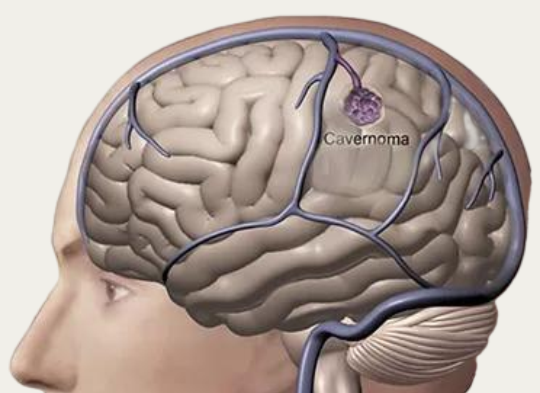Cavernoma

Cavernoma
Cavernoma, also known as cerebral cavernous malformations or CCMs, are clusters of abnormal blood vessels primarily found in the brain and spinal cord. These formations are important to understand due to their potential to cause symptoms and require treatment. This section provides comprehensive information on what cavernomas are, the available treatment options, and what recovery may look like.
What is a cavernoma?
- Description: a cavernoma is a appears as a grape-like cluster of blood vessels that can range from a few millimeters to several centimeters in size. They are most often located in the brain or spinal cord and can change in size and number over time.
- Symptoms: while some individuals may experience no symptoms at all, others might encounter headaches, seizures, hemorrhages, or neurological problems such as weakness, vision loss, or difficulties with balance and memory.
- Diagnosis: cavernomas are most commonly diagnosed using magnetic resonance imaging
(MRI) which provides a detailed image of the brain and spinal cord, allowing for the accurate detection of these abnormalities.
Treatment options
- Medical engagement: For patients without symptoms, or for those whose symptoms are manageable, doctors may recommend regular monitoring with MRIs.
- Surgical Treatments: When a cavernoma causes significant symptoms or bleeding, surgical removal may be considered. Every case is carefully assessed by a neurosurgeon to determine whether surgery is necessary.
- Risks and considerations: Surgery may carry risks such as infection, bleeding, or neurological changes. It’s important to follow your doctor’s advice and discuss all potential risks and outcomes before proceeding.
Recovery and management
- Immediate Post-Treatment Care: Recovery immediately following surgery typically involves a short hospital stay where patients are monitored for complications. The length of stay varies depending on the individual's condition and the complexity of the surgery.
- Long-Term Recovery: Post-surgical recovery time could be various and different from person to person. Patients may need rehabilitation services to manage and recover neurological functions.
- Lifestyle Adjustments: Patients might be advised to avoid certain activities that increase the risk of bleeding or seizures. Regular health check-ups are crucial.
- Support Systems: Engaging with a healthcare team, including neurologists and rehabilitation specialists, is essential. Support groups and counseling can also be beneficial in managing the emotional and psychological impacts of living with a cavernoma.
Living with a cavernoma
- Monitoring: Regular monitoring through MRIs is crucial to track any changes in the cavernoma that might require adjustments in treatment.
- Impact on Life: Living with a cavernoma can affect more than just physical health; it can impact emotional and social aspects of life as well. It's important to seek holistic care and support.
- Resources and Support: Seek help from local hospitals, community groups, and counseling services. Family, friends, and workplace accommodations can also provide vital emotional and practical support.
References
- "Cavernous Malformations." National Institute of Neurological Disorders and Stroke. Available at: NINDS website
- "Cerebral Cavernous Malformation." Mayo Clinic. Available at: Mayo Clinic website
- Cavernoma Alliance." A resource for individuals and families affected by cavernomas. Available at: Angioma Alliance website
- Neurocirurgia BH. (n.d.). Cavernoma. Retrieved October 17, 2024
Disclaimer: The information provided here reflects personal knowledge and experience and is not a substitute for professional medical advice. Always consult your healthcare provider for medical concerns. In an emergency, call 911 immediately.
